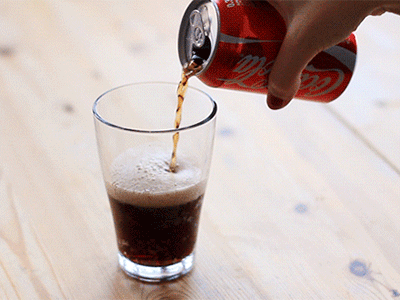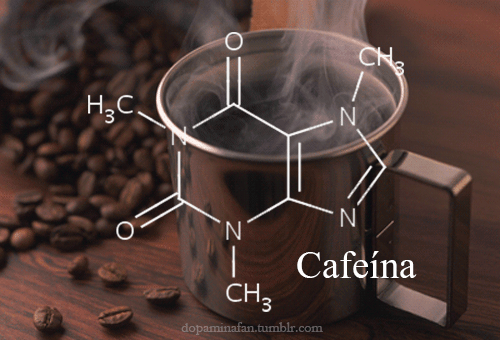DAMAGE FROM EXCESSIVE CONSUMPTION OF CARBONATED SOFT DRINKS IN THE BODY.

The soft drink is a flavored, effervescent and alcohol-free beverage, usually consumed cold to be more refreshing and avoid the loss of carbon dioxide that gives it effervescence. In 1832, Jhon Matthews invented an appliance capable of mixing water, carbon dioxide and flavor and thus created a business known as a source of sodas, likewise sold in pharmacies as a remedy. The currently known Dr Pepper sodas that are still beverages in the United States, and Coca-Cola were the result of the development of pharmacists experimenting with their soda sources and it was believed that sodas had a positive effect on health, for example, were sold as tonics for headaches and even digestion, because carbonated water releases carbon dioxide, which when in the stomach gives off
When talking about soft drinks, it is impossible to ignore the legendary rivalry between Coca-Cola and Pepsi, which reached its peak with the famous "Pepsi Challenge" in 1975, which consisted of making passers-by taste both soft drinks without them knowing which one was which, and finally asking them which one they liked best. Although Coca-Cola was created several years earlier and Pepsi had to face two bankruptcies in a very short time in the middle of the 20th century, both have managed to remain in force through clearly defined strategies that contrast the familiar atmosphere with fashion trends, respectively.
In relation to the aforementioned, it should be noted that the majority of its consumption is due to a great fashion that is mostly generated by adolescents, leaving aside their knowledge of the damage being caused to the body, and thus leaving aside health and well-being.
curious fact: The consumption of sugary drinks has been doubled by children and adolescents, with the consequence that a child suffers from obesity, diabetes and other diseases related to this subject. In the world there is a need to reduce the consumption of soft drinks, it is essential to know that although its taste is pleasant, there are healthy drinks of different flavors that provide a healthier and longer life, such as natural juices and water. It is important to know that the excessive consumption of carbonated beverages in Venezuela is high, its excessive intake produces mostly diabetes, cardiovascular diseases, metabolic syndrome, hypertension and high triglycerides.
Soft drinks
It is a flavored, effervescent and alcohol-free beverage. These drinks are usually consumed cold, to be more refreshing and to avoid the loss of carbon dioxide, which gives it effervescence.
carbonated water
Water is a colorless substance that is formed by two hydrogen atoos and an oxygen atom and is the most abundant behavior on the Earth's surface. If carbonic acid is added to the water, a reaction occurs because this acid decomposes and releases carbon dioxide as bubbles if the liquid is depressurized. The result is called carbonated water.
Caffeine
Its natural origin is coffee: The caffeine contained in popular beverages are no more than additives to provoke addiction in consumers than to give it flavor. A can of soda and if specified, contain 38 mg of caffeine, which is considered a stimulant and causes behavioral changes. Caffeine has been compared in a form compatible with Methylphenidate and amphetamines, which are prescription-only stimulants. People who consume caffeine will feel the same effects in their bodies as morphine, quinine, nicotine, cocaine and strychnine. Because they all belong to the same group of alkaloids. When this substance is consumed in high quantities it can cause insomnia, weakness, fatigue, ulcers, interference with the digestion of proteins and with the regulation of intestinal functions leading to vomiting and diarrhea, it also causes haemorrhages of the skin, cataracts, albinism, alteration to the red blood cells, hydrocephalus, hemorrhages of the eyes, bone deficiency being also if consumed cold, accelerates its action. This substance is mainly dangerous for children because it causes incontinence in the urine (children who urinate in bed) nightmares, memory loss, loss of balance, insomnia, fatigue, finger tremor, fear, anxiety, stress, hyperactivity and depression. Caffeine is also associated with first trimester abortions, which is why in 1980 the FDA. recommended that pregnant women eliminate this substance and any product containing it.
Aspartame
is a low-calorie sweetener used in foods and beverages in more than 100 countries worldwide. It is approximately 200 times sweeter than sugar. If used as a substitute for sugar, it can substantially reduce calories in foods and even eliminate them completely in some products. Aspartame was approved by the U. S. Food and Drug Administration (FDA) in 1981 for use as a powder and low-calorie table sweetener, and was soon approved for use in carbonated beverages in 1983. In 1996, it was approved for use in all foods and beverages, including products such as syrups, salad dressings and certain snacks for which approval had not yet been granted. Prior to its approval, aspartame was subjected to one of the most thorough and thorough scientific reviews ever conducted, and is considered by regulators to be one of the most successfully tested ingredients. The safety of aspartame has been affirmed by the FDA and independent health care groups, such as the American Medical Association, the American Dietetic Association and the Diabetes Association of the United States. The rapid growth and widespread use of aspartame in foods has given rise to much publicity and, for that reason, people are asking themselves many questions about this ingredient.
Phosphoric acid
It is a relatively weak anorganic acid that is used in the food industry as a preservative, emulsifier, acidifier (in cola drinks) or as an acidity corrector. In high concentrations this acid irritates the skin and mucous membranes. Phosphoric acid is also harmful for calcium in bones, because it does not allow adequate absorption in the body, causing its weakening and therefore increasing the possibility of fractures, it is also said that phosphoric acid is one of the major contributors to increased osteoporosis.
Sodium Benzoate
Sodium benzoate is a bacteriostatic and fungistatic that is added together with citric acid to preserve liquid foods for a long time. Both form benzine, a potent carcinogen. In other foods, it is often found with dyes such as red #40 or yellow #5. It is also known that other dyes can cause allergies.
Potassium Benzoate
It is a preservative, bactericide and fungicide. Effects: For people with asthma, who are allergic to aspirin or have hives at intervals, they may be susceptible to potassium benzoate and have allergic reactions.
Potassium benzoate should not be added in foods intended for babies and children, however it is also present in soft drinks consumed by children. It is also included in the list of additives, avoided for hyperactive children.
Citric Acid
In its natural state it can be found in lemons and other citrus juices, but in the soft drink appears artificially, it is commercially manufactured by fermenting molasses with strains of microorganisms Aspergillus Niger. If citric acid is consumed in very large amounts, it can cause tooth erosion and local irritation.
The human body stops bone growth at the age of thirty, dissolving later in urine, depending on the acidity of the food ingested, all dissolved calcium compounds accumulate in the arteries, veins or tissues of the skin, affecting kidney function as well.

Diabetes
According to the World Health Organization (WHO), diabetes is defined as follows:"Diabetes is a chronic disease that appears when the pancreas does not produce enough insulin or when the body does not use the insulin it produces effectively. The effect of uncontrolled diabetes is hyperglycemia."
Pancreatic cancer
Pancreatic or pancreatic cancer is a tumor that originates in the pancreatic glancula. It is one of the most aggressive neoplasms due to its rapid spread, lack of early specific symptoms and late diagnosis, at the time of diagnosis, patients usually have locally advanced and even metastatic disease, which prevents curative surgery.
The relationship between sugary sodas and pancreatic cancer was developed in a study (2010) that consisted of drinking two soft drinks, it was noted that:"The sugar in soft drinks raises the body's insulin level, something that contributes to the development of pancreatic cancer. This increase in insulin is what could be leading to cancer development.
cardiovascular diseases
According to the World Health Organization (WHO), cardiovascular diseases are defined as follows:"they are due to disorders of the heart and blood vessels, including coronary heart disease (heart attacks), cerebrovascular disease (stroke), increased blood pressure (hypertension), peripheral vascular diseases, rheumatic heart disease, congenital heart disease and heart failure.
High blood pressure
According to the National Institute of Nutrition defines arterial hypertension as follows:"is the rise in blood pressure above 120/80 mmHg". People are more likely to be told that their blood pressure is too high as they get older. This is because blood vessels become stiffer with age, and when this happens, blood pressure rises.
Nausea
Nausea is a sensation that indicates the proximity of vomiting and efforts that accompany the need to vomit. These are manifested as a discomfort in the stomach, associated with a feeling of vomiting.
Tooth decay
Colgate defines cavities as follows:"Tooth decay is the destruction of tooth tissues caused by the presence of acids produced by plaque bacteria deposited on dental surfaces. This tooth decay is strongly influenced by lifestyle, i. e. it influences what we eat, the way we care for our teeth (our hygiene habits), the presence of fluoride in the salt and the toothpaste we use. Heredity also plays an important role in the susceptibility of your teeth to decay." Sugar and acid in soft drinks easily dissolve tooth enamel, when cavities reach the nerve, root and area at the base of the tooth, the tooth may die, and if not treated in time it will form an abscess.
Overweight and obesity
According to the World Health Organization (WHO), overweight and obesity are said to be:"Overweight and obesity are defined as an abnormal or excessive accumulation of fat that can be harmful to health. The link between obesity and soda is so close that doctors estimate that for every soda consumed, the likelihood of developing obesity increases 1.6 times. In addition to the above, 70% of cardiovascular diseases are caused by obesity; 42% of colon and breast cancer is diagnosed in obese individuals; 30% of gallbladder operations are related to obesity.
High blood pressure
According to the National Institute of Nutrition defines arterial hypertension as follows:"is the rise in blood pressure above 120/80 mmHg". People are more likely to be told that their blood pressure is too high as they get older. This is because blood vessels become stiffer with age, and when this happens, blood pressure rises.
Nausea
Nausea is a sensation that indicates the proximity of vomiting and efforts that accompany the need to vomit. These are manifested as a discomfort in the stomach, associated with a feeling of vomiting.
Tooth decay
Colgate defines cavities as follows:"Tooth decay is the destruction of tooth tissues caused by the presence of acids produced by plaque bacteria deposited on dental surfaces. This tooth decay is strongly influenced by lifestyle, i. e. it influences what we eat, the way we care for our teeth (our hygiene habits), the presence of fluoride in the salt and the toothpaste we use. Heredity also plays an important role in the susceptibility of your teeth to decay." Sugar and acid in soft drinks easily dissolve tooth enamel, when cavities reach the nerve, root and area at the base of the tooth, the tooth may die, and if not treated in time it will form an abscess.
Overweight and obesity
According to the World Health Organization (WHO), overweight and obesity are said to be:"Overweight and obesity are defined as an abnormal or excessive accumulation of fat that can be harmful to health. The link between obesity and soda is so close that doctors estimate that for every soda consumed, the likelihood of developing obesity increases 1.6 times. In addition to the above, 70% of cardiovascular diseases are caused by obesity; 42% of colon and breast cancer is diagnosed in obese individuals; 30% of gallbladder operations are related to obesity.
Conclusion
In this in-depth investigation it could be demonstrated that the exvesos of sodas or soft drinks in our organism represent great amount of risks carrying out different diseases with difficult cures or experiencing unwanted moments in the life of the human being, therefore a great advice to all steemians that embrace this great network to have a healthy life.
Source information
https://www.rodalesorganiclife.com/wellbeing/9-disturbing-side-effects-of-soda%3Fslide%3D1
https://universityhealthnews.com/daily/nutrition/what-does-soda-do-to-your-body/






